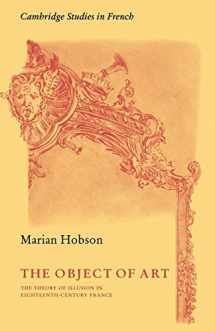
The Object of Art: The Theory of Illusion in Eighteenth-Century France (Cambridge Studies in French, Series Number 3)
Book details
Summary
Description
Are works of art imitations? If so, what exactly do they imitate? Should an artist remind his audience that what it is perceiving is in fact artifice, or should he try above all to persuade it to accept the illusion as reality? Questions such as these, which have dominated aesthetic theory since the Greeks, were debated with extraordinary vigour and ingenuity in eighteenth-century France. In this book Dr Hobson analyses these debates, focusing in turn on painting, the novel, drama, poetry and music. In each case she relates theory to contemporary works of art by Watteau, Chardin, Diderot, Beaumarchais, Gluck and many others. She shows that disputes within the theory of each art centred upon the nature of the perceiver's attention. Dr Hobson provides a method of mapping the changes in artistic style which took place as the century advanced. In discussing such conceptual transformations Dr Hobson opens an important perspective for the study of Romanticism and Realism.


We would LOVE it if you could help us and other readers by reviewing the book
Book review



